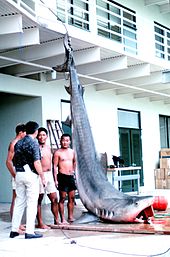Shark culling
[2][3][4][5][6][7] Government officials often cite public safety (attempting to reduce the risk of shark attacks) as a reason for culling.[8][9] The impact of culling is also minor compared to bycatch with 50 million sharks caught each year by the commercial fishing industry.[15] Christopher Neff, a Ph.D. scholar at the University of Sydney notes, "Internationally, shark nets have been labeled a 'key threatening process' for killing endangered species."He adds:" ... killing endangered species to boost public confidence or to show government action is not workable.[1] Drum lines have been criticized for being environmentally destructive and speciesist, and have sparked public demonstrations and vocal opposition, particularly from environmentalists, animal welfare advocates and ocean activists.[6] In addition, Western Australia Fisheries Minister Dave Kelly said "there is currently no scientific evidence to show that drumlines reduce the risk of a [shark] attack".[16][11] The current net program in New South Wales has been described as being "extremely destructive" to marine life, including sharks.Also during this period, a total of 15,135 marine animals were killed in the nets, including whales, turtles, rays, dolphins, and dugongs.[22] Following 11 shark attacks along the New South Wales north coast between 2014 and 2016, including two fatalities,[23] shark nets and "smart" drum lines were deployed in December 2016 to cover five additional beaches along the New South Wales North Coast in a six-month trial.The state's shark control policy has captured over 5,000 turtles, 1,014 dolphins, nearly 700 dugongs and 120 whales, all of which are federally protected marine species.[40] National Geographic cameraman Andy Casagrande said the following about the cull: "When will basic intelligence and respect for the planet be a requirement for highly paid supposedly educated government officials?[12][41] The region's shark attack statistics primarily reflect the effectiveness of netting, as drum lines were only introduced recently, following their successful use for over 40 years in Queensland, Australia.[56] In November 2018, more than 7,000 Western Australians signed a petition demanding that the planned "SMART" drum line trial be abandoned.[57] In January 2019 the Environmental Protection Authority of Western Australia determined that the "SMART" drumline trial would have minimal impact on the environment."[33] In 2017, "Humane Society International applied for lethal shark control programs in New South Wales and Queensland to be listed as “key threatening processes” under the federal Environment Protection and Biodiversity Conservation Act [of Australia].But scientists argue that while such hunts may quench the public's desire for vengeance after a [shark] attack, they do little to reduce the likelihood of another one.[67][50][66][79] The Sea Shepherd group says, "private investors are trialing various programs such as electronic deterrents, drones, the Eco Shark Barrier at a local beach in Perth, and smart phone applications which use social media to advise the community of where sharks are spotted".[80] The NSW prawn trawling industry alone results in 64 tonnes of shark as bycatch each year,[64] with two thirds dying.[81] Tuna and swordfish longline fishing off the coast of South Africa reported 39,000 to 43,000 sharks killed each year between 1995 and 2005.[81] Sharksavers estimates that in total 50 million sharks are caught unintentionally each year as bycatch by the commercial fishing industry.

tiger sharkKāne'ohe Bayshark attacksmarine ecosystembycatchcommercial fishingNew South WalesQueenslandKwaZulu-NatalRéunionShark netChristopher NeffDrum linespeciesistWestern Australiagrey nurse sharksdolphinsgreen sea turtlesgreat white sharkstiger sharkswhalesturtlesdugongsshark netsSydneyNewcastleWollongongdrum lineshammerhead sharksbull sharksloggerhead turtlesmanta rayshawksbill turtlesSunshine CoastTownsvilleMackayCairnsAmity PointJohn McVeighAustralian Marine Conservation SocietyWhitsunday IslandsSea ShepherdGreat Barrier ReefHumane Society InternationalKwaZulu-Natal, South AfricaKwaZulu-Natal Sharks BoardDurbanGeorge H. BurgessDunedin, New ZealandNative HawaiiansHawaiian cultureaumakuaWestern Australian shark cullshark cull in Western AustraliaEnvironmental Protection Authority of Western AustraliaQueensland GovernmentQueensland State GovernmentNSW State GovernmentLiberal National Party of Queenslandthe French Overseas Department of Réunionlong linesanimal rightsSea Shepherd Conservation SocietyAustralian Greens Partygovernment of Western AustraliaInternational Shark Attack FilesurfersRecife, BrazilCape Town, South AfricaShark attackShark attack preventionSpeciesismClose to ShoreMichael CapuzzoJersey Shore shark attacks of 1916The Devil's TeethSusan CaseyTwelve Days of TerrorBibcodeThe New Zealand HeraldTheGuardian.comSharksOutline of sharksShark anatomyShark toothEgg case (Chondrichthyes)Threat displayThreatened sharksCarcharhiniformes (Ground sharks)Heterodontiformes (Bullhead sharks)HexanchiformesLamniformes (Mackerel sharks)Orectolobiformes (Carpet sharks)Pristiophoriformes (Sawsharks)SqualiformesSquatiniformes (Angelsharks)CladoselachiformesHybodontiformesSymmoriidaXenacanthida (Xenacantiformes)List of sharksAustraliaSouth AfricaSouth AustraliaUnited StatesShark cage divingShark tourismSharks in popular cultureShark sanctuaryShark AllianceU.S. Shark Conservation ActGrey nurse shark conservationSave Our Seas Foundation